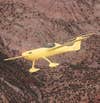The Tiny, Perfect Little Flying Machine
Cory Bird, an engineer at Burt Rutan's remarkable aviation design shop, builds a composite-fiber airplane of Swiss-watch precision.
When a yellow two-seater called Symmetry flew for the first time in California last April, a machine that is very likely the most finely crafted handmade artifact of its type took to the air. Certainly I’d wager that Symmetry comes closer to perfection than any other homebuilt airplane in the world, and it deserves equal measures of admiration and incredulity. Admiration for the precision of the machine, incredulity for the obsession that produced it. This is technology as aviation art, from the hands of one man.
I’ve seen a lot of homebuilts and made one myself–an Italian-designed Falco that some people, stroking my ego, said was a pretty obsessively constructed beauty. Parked next to Symmetry, however, my spruce speedster would have looked like a sorry piece of plywood trash. And my “obsessiveness” would have seemed like slapdash carpentry compared to builder Cory Bird’s pursuit of perfection.
Quite simply, Symmetry is not only symmetrical but dead-nuts flawless. The airplane’s fuselage is as lithe and sinuous as a tango dancer’s outthrust leg. Its wings are literally as straight and true as a draftsman’s steel rule. Next to its nine coats of hand-rubbed acrylic urethane (seven pigmented, two clear), the $60,000 paint jobs on many a concours-winning collector car would look like Earl Scheib re-sprays. Under harsh fluorescent hangar lights that would make even a brand-new Mercedes appear to have been painted with a broom, Symmetry reveals nary ripple nor flaw.
When I first saw Symmetry, in its hangar at Mojave Airport in California’s high desert, I peered into the uncowled engine compartment and marveled at the amount of extra machinery that extended back into the space between the four-cylinder, 200-horsepower Lycoming engine and what I assumed was the front of the cockpit–hoses, tubing, pumps, wires, an extra pair of magnetos . . .
Wait a minute, extra magnetos? I realized that Symmetry’s stainless-steel firewall had been polished to an absolute mirror finish and was simply reflecting the back of the engine, fooling my eye into seeing space where in fact there was hard steel.
All aircraft are pockmarked with access panels, inspection plates, fairings, fillets and fasteners. Except for this one. Half a dozen tiny screw-heads and a few hairline seams are the only interruptions in Symmetry’s glassy surface. The Pitot tube is a minute opening in the nose of the left wheel pant. The fuel-tank drains on the belly are what the industry calls flush drains, which generally have an eighth-inch protrusion beyond the skin of the airplane. An eighth inch too far for Cory Bird, who totally remachined the stock push-up drains and mounted them in bushings that are, well, flush. Even the necessary cowling access door for the oil dipstick has no visible fastener; to open it, you reach into a cowling air intake and spring an internal latch.
And that entire cowling is itself held in place not by dozens of unsightly machine screws, as is typical, but solely by a circumferential tongue that fits so perfectly into a groove around the firewall that the two cowling halves need to be popped free with a slap to release the air pressure when they are removed.
The airplane’s few seams–where the cowling and canopy mate with the fuselage, mainly–are so narrow, true and temperature-sensitive that at 70

Under the Hood

She’s a Real Beauty

Under the Hood

by John B. Carnett

Under the Hood

Bird by the Numbers
Wingspan: 25 feet
Wing area: 64.5 square feet
Empty weight: 975 pounds
Stall speed: 68 knots/78 mph Approach speed,
15 degrees flap: 95 knots/109 mph
Top speed: 230 knots/ 265 mph*
Rate of climb: 2,500 feet per minute
*Estimate–aircraft still in flight-testing